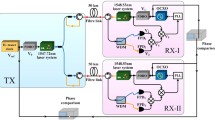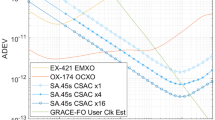Abstract
A satellite communication system suitable for distribution of local oscillator reference signals for a widely spaced microwave array has been developed and tested experimentally. The system uses a round-trip correction method to remove effects of atmospheric fluctuations and radial motion of the satellite. This experiment was carried out using Telstar-5, a commercial Ku-band geostationary satellite. A typical Ku-band satellite has uplink and downlink capacity at 14–14.5 GHz and 11.7–12.2 GHz, respectively. For this initial experiment, both earth stations were located at the same site to facilitate direct comparison of the received signals. The local oscillator reference frequency was chosen to be 300 MHz and was sent as the difference between two Ku-band tones. The residual error after applying the round trip correction has been measured to be better than 3 ps for integration times ranging from 1 to 2000 s. For integration times greater than 500 s, the system outperforms a pair of hydrogen masers with the limitation believed to be ground-based equipment phase stability. The idea of distributing local oscillators using a geostationary satellite is not new; several researchers experimented with this technique in the eighties, but the achieved accuracy was 3 to 100 times worse than the present results. Since then, the cost of both leased satellite bandwidth and the Ku-band ground equipment has dropped substantially and the performance of various components has improved. An important factor is the availability of narrow bands which can be leased on a communications satellite. We lease three 100 kHz bands at approximately one hundredth the cost of a full 36 MHz-wide transponder. Further tests of the system using terminals separated by large distances and comparison tests with two hydrogen masers and radio interferometry of astronomical objects are needed.
Similar content being viewed by others
References
Ables, S. T.: 1989, ‘A Report on the Phase Stability of the AUSSAT Phase Transfer System’, ATNF Internal Document.
Allan, D. W., Weiss, M. A. and Jespersen, J. L.: 1991, ‘A Frequency-Domain View of Time-Domain Characterization of Clocks and Time and Frequency Distribution Systems’, Proceedings of the 45th Annual IEEE Symposium on Frequency Control, pp. 667–678.
Bardin, J.: in preparation, ‘Local Oscillator Distribution Using a Commercial Geostationary Satellite’, M. S. Thesis, Electrical Engineering Department, University of California, Los Angeles.
Cannon, W. H. et al.: 1982, ‘Phase Stable Long Baseline Interferometry Via a Satellite Link’, Very Long Baseline Interferometry Techniques, Cepadues Editions, Toulouse, pp. 443–459.
Gardner, F.: 1979, Phaselock Techniques, John Wiley and Sons, New York.
Thompson, A. R., Moran, J. M. and Swenson, G. W. Jr.: 2001, Interferometry and Synthesis in Radio Astronomy, 2nd ed., Wiley Interscience, New York.
Van Ardenne, A. et al.: 1983, ‘A High-Precision Phase-Comparison Experiment Using a Geostationary Satellite’, IEEE Trans. Instrum. Meas., IM-32, 370–376.
Walker, R. C.: 1999, ‘Very Long Baseline Interferometry’, Synthesis Imaging in Radio Astronomy II, Astronomical Society of the Pacific, San Fransisco, pp. 433–462.
Yen, J. L. et al.: 1977, ‘Real-Time Very-Long Baseline Interferometry Based on the Use of a Communications Satellite’, Science, 198.
Author information
Authors and Affiliations
Corresponding author
Rights and permissions
About this article
Cite this article
Bardin, J., Weinreb, S. & Bagri, D. Local Oscillator Distribution Using A Geostationary Satellite. Exp Astron 17, 193–199 (2004). https://doi.org/10.1007/s10686-005-0032-9
Received:
Accepted:
Issue Date:
DOI: https://doi.org/10.1007/s10686-005-0032-9




